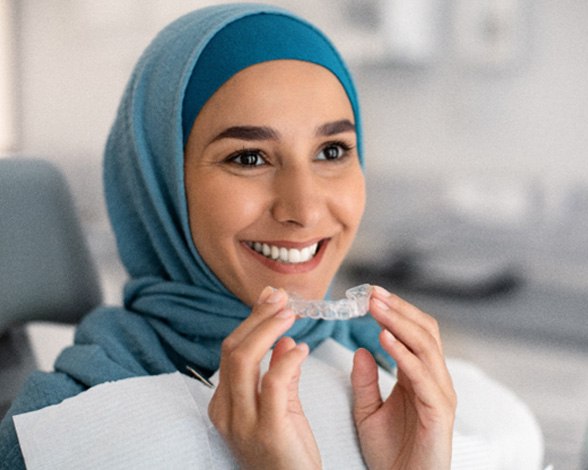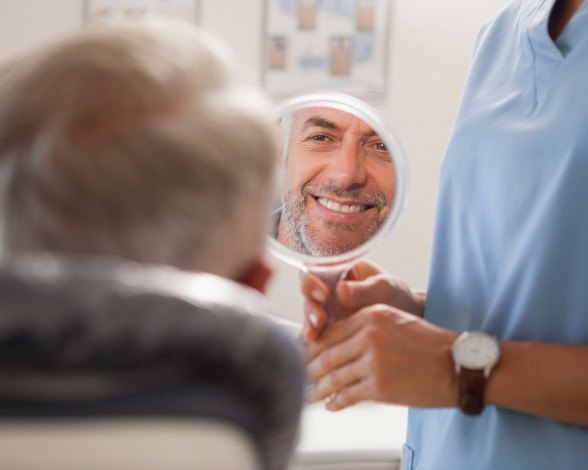If you’ve been wanting to straighten your teeth but haven’t moved forward with orthodontic treatment because of the metal brackets and wires, there’s good news; Invisalign® clear aligners can improve the position of your teeth and the alignment of your bite without the metal. You can learn more about how the treatment process works, the benefits of this innovative teeth-straightening solution, and the cost right here. Or, you can get in touch with our team to schedule a consultation!
Why Choose A New Smile for Invisalign® Clear Aligners?
- Expertly Personalized Clear Aligners
- Team That Offers Excellent Customer Service
- Flexible Financing Available
How Invisalign Works
While traditional braces gently move your teeth with metal brackets and wires, Invisalign® accomplishes the same goal with a series of custom-made clear aligners. You’ll wear each one for 7-14 days, which will give your teeth enough time to move a step closer to their properly aligned positions. Then, when you move onto the next tray in the series, it will pick up where the last one left off. In an average of just 12-18 months, you’ll have straight teeth and a gorgeous smile!
Indications for Invisalign
Invisalign® uses clear aligners, attachments, and other accessories (like rubber bands) to correct common orthodontic problems. At your consultation, your Pacoima dentist will conduct a comprehensive oral exam to determine if you’re a candidate for Invisalign® and, if you are, what your teeth-straightening journey will look like. In the meantime, keep reading to learn a little more about crowded teeth, gaps between teeth, and bite problems.

Crowded Teeth
Overcrowded teeth are one of the most common orthodontic issues. The good news is that Invisalign® can address even more moderate cases, so don’t automatically assume that traditional braces are your only option! Oftentimes, with the help of attachments and interproximal reduction, the process of moving your teeth into their properly aligned positions doesn’t require any metal at all.

Gaps Between Teeth
Whether there are small gaps between all of your teeth or a large gap between your two front teeth, don’t worry – Invisalign® can move your teeth closer and closer together. The first step is scheduling a consultation with us so we can learn more about your dental history and oral health as well as the severity of your case. The good news is that the average treatment timeline with clear aligners is only 12-18 months, so it won’t be long until you have your dream smile if you’re a candidate for Invisalign®!
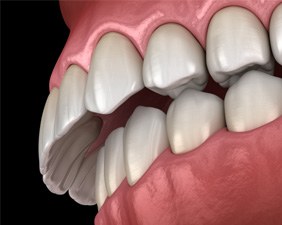
Overbite
Another common orthodontic problem is an overbite, which is when the upper teeth jut out beyond the lower ones. If you think you have this bite issue, then don’t hesitate to schedule a consultation with us to find out if you’re a candidate for Invisalign®. That way, we can bring your teeth and your bite into proper alignment before you experience trouble chewing, chronic jaw pain, and the like.
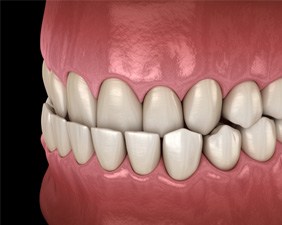
Underbite
What if your lower teeth sit in front of your upper ones? Since the jaw is in an unnatural position, many patients with this orthodontic problem (known as an “underbite”) experience chronic pain, low self-esteem, and several other complications. Fortunately, cases that aren’t too severe can be fixed with clear aligners, which means you won’t have to wear metal brackets or wires to achieve your dream smile.
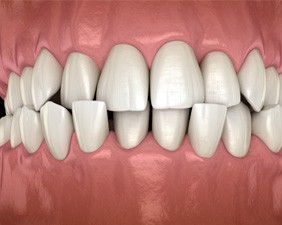
Crossbite
In addition to making it difficult to smile with confidence, crossbites can make it difficult to chew and speak properly. Plus, there is always the risk of chronic jaw pain, TMJ dysfunction, and premature wear and tear. So, don’t wait to explore your treatment options! You might be surprised to learn that you’re a candidate for Invisalign®!

Open Bite
Is there space in the front or back of your mouth when you bite down? If so, come in to see if we can bring your bite into proper alignment with Invisalign®! At your consultation, we’ll see if clear aligners (combined with buttons or any other orthodontic accessories) are the solution.
The Benefits of Invisalign
Patients always talk about how discreet Invisalign® clear aligners are. While that’s certainly a benefit, there are also several others that are equally as noteworthy, including:
- The average treatment timeline is only 12-18 months.
- There aren’t any dietary restrictions.
- Brushing and flossing is a breeze – just remove your trays first!
- There are fewer check-in visits.
- Each aligner is custom-made for you, making them quite comfortable.
Living with Invisalign Aligners
Since Invisalign is one of the most popular orthodontic treatments, there’s a good chance that you already know a bit about it, including the fact that the aligners are completely see-through. Of course, you need to know a lot more than that in order to determine if it’s right for you. That’s why we’ve dedicated this next section to covering helpful information about living with Invisalign!

Wearing Your Trays
Although each Invisalign treatment plan is unique, there is a commonality: they all require patients to wear the aligners for 20-22 hours a day. As you can see, that doesn’t leave a lot of wiggle room. For that reason, we recommend using the stopwatch on your phone to track your wear time so you know how close or far you are from the mark. Then, make the necessary adjustments! It may take some work, but it’s crucial when it comes to avoiding treatment plan delays.

Cleaning Your Aligners
Good news: cleaning your Invisalign aligners won’t take a lot of time or require a lot of products. In fact, there’s a good chance that you already have everything you need: a soft-bristled toothbrush, clean, cool water, and mild, clear dishwashing liquid. In addition to getting in the habit of rinsing your trays with clean, cool water each time you take them out, start cleaning them with the previously mentioned items each morning when you wake up and each evening before you go to bed.

Eating & Drinking
Many patients are thrilled to hear that they don’t need to completely eliminate any foods from their diet with Invisalign. While that’s true, there are some that we recommend steering clear of, or, at the very least, exercising caution with, like hard pretzels and popcorn. Ideally, your breakfast, lunch, and dinner will be filled with smile-friendly foods, like oatmeal, scrambled eggs, and plain yogurt. That way, your teeth and gums stay healthy, and any attachments you have stay in place!

Losing or Damaging a Tray
DIY solutions, like using superglue to piece your aligner back together or moving onto the next set of aligners in the series without telling us, are not recommended. Instead, you should contact us ASAP to share what happened. From there, we can look at your treatment plan and determine if it’s safe to continue wearing your aligners, if a replacement needs to be made, or if you can move onto the next set a bit early.

Routine Check-Ins
Every six or eight weeks, you’ll come to our office so we can monitor the movement of your teeth. We do this by taking new scans, which only takes a few minutes. If you are on-track with your treatment plan, then we will provide you with the next set in the series and see you at your next visit. If you aren’t on-track, then we will need to come up with a game plan, like having you wear your current aligners for a bit longer.
Understanding the Cost of Invisalign
Before you get Invisalign, you’ll want to learn its price first. That’s only natural - you must know whether the treatment will fit your budget. Still, the cost of Invisalign varies from patient to patient. Our dentists can only give you an exact price at your consultation. From there, our team will strive to make your care affordable. We’ll even guide you through Invisalign’s cost factors and payment options. For more details, just keep reading or call our office.
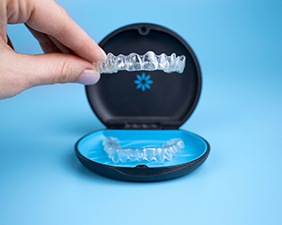
Factors That Affect the Cost of Invisalign
At the consultation visit, you’ll have an oral exam. This process lets us confirm the factors that impact your treatment cost. Among these, the most notable ones are:
- Arch Number – While Invisalign often treats both arches, it doesn’t always. You can get it for just one arch at a cheaper price.
- Treatment Complexity – When Invisalign involves complex tooth movements, it gets more expensive.
- Treatment Timeline – As treatment time increases, the number of aligners you need will also rise. That’ll eventually lead to a pricier procedure.
- Patient Compliance – If you neglect Invisalign best practices, your treatment results will be delayed. Said delay will then lead to a higher expense.

Invisalign vs. Smile Direct Club™: Which Costs More?
Really, Invisalign has a higher upfront price than Smile Direct Club™. The first option charges $3,000 to $8,000, while the second costs under $2,000. Given that fact, you could easily view Smile Direct Club™ as the cost-effective choice.
All that said, don’t forget: Smile Direct Club™ is a DIY aligner kit. It doesn't enjoy oversight from a qualified dental team. As such, using it can lead to mistakes – poorly-made dental impressions, bad aligner habits, etc. Your smile would need professional help if such errors occurred.
In contrast, Invisalign lacks the oversight problem. It benefits from our dentists’ constant input and feedback. Therefore, choosing it will lead to high-grade impressions and more successful care. The procedure’s cost is justified in that case.

Does Dental Insurance Cover Invisalign?
Dental insurance usually won’t cover Invisalign. In fact, it often won’t apply to orthodontics at all. Even plans that make room for alignment work will exclude Invisalign.
Of course, there are exceptions. Plans exist that can cover up to 50% of Invisalign’s cost. So, confirm your benefits before deciding anything. Our team can help you do so by reaching your plan provider.

Options for Making Invisalign Affordable
Luckily, insurance isn’t the only way to make Invisalign affordable. Other good ones are a dental practice’s various payment options. For example, A New Smile offers:
- Special Offers – If you see us for Invisalign, our team will give you a free oral exam and dental X-rays.
- Flexible Financing – As it happens, our office works with CareCredit. This financier would let you pay for Invisalign in monthly installments. By doing so, you could cover the aligners’ cost gradually instead of all at once.
Our team wants your Invisalign journey to be budget-friendly. Therefore, book a visit with our office to learn more about financing it.
Invisalign FAQs
What Does Invisalign Look Like?
Invisalign clear aligners are made from a proprietary clear plastic that fits tightly to your teeth. While they’re easy to see once you take them out, they turn nearly invisible when placed over your pearly whites. This makes it very difficult for anyone looking at your smile to tell that you’re doing orthodontic treatment. However, the aligners aren’t immune to staining. This is why it’s very important that you take them out to eat or drink (except water). In some cases, you may need attachments or buttons to help facilitate your treatment. These are small tooth-colored “bumps” that are slightly more visible but shouldn’t be distracting or detract from your smile.
How Long Does Invisalign Take?
Invisalign treatment can take as little as six months or as long as 18 to fully straighten your smile. It all depends on the severity of your dental issues, your treatment goals, and your adherence to the treatment program. If you want to ensure a nice, straight smile with Invisalign aligners, it’s important to follow all your dental expert’s advice, visit us regularly for checkups, and maintain excellent oral hygiene. Also, it’s important to remember that even if your smile requires the maximum timespan, it’s still four months faster than traditional braces!
Does Invisalign Hurt?
Invisalign clear aligners are one of the most comfortable forms of orthodontic treatment available. The smooth plastic doesn’t irritate your gums or pose a risk of cutting your lips or cheeks like traditional braces. However, they can still cause sensitivity and even soreness in your teeth when you first start wearing them and each time you switch to your next aligner. While these adjustment periods are brief, they can still be uncomfortable. So, be prepared to switch to a soft food diet of warm soups, bananas, eggs, and mashed potatoes for a couple of days every two weeks. Over-the-counter pain medications like ibuprofen can also help manage your discomfort.
What Happens After Invisalign?
While completing your Invisalign treatment means that you no longer need to wear your aligners, it’s not truly the end of your journey. Post-treatment maintenance begins with receiving your retainer which is designed to help keep your results. Without it, your teeth would slowly begin to shift back into their original positions, undoing all your hard work. Based on your specific treatment needs, your dental professional will give you different guidelines on when to wear your retainer and how often it needs to be used. However, no matter your results, your retainer will be a part of your regular dental care routine from now on!
What Does Invisalign Look Like?
Invisalign clear aligners are made from a proprietary clear plastic that fits tightly to your teeth. While they’re easy to see once you take them out, they turn nearly invisible when placed over your pearly whites. This makes it very difficult for anyone looking at your smile to tell that you’re doing orthodontic treatment. However, the aligners aren’t immune to staining. This is why it’s very important that you take them out to eat or drink (except water). In some cases, you may need attachments or buttons to help facilitate your treatment. These are small tooth-colored “bumps” that are slightly more visible but shouldn’t be distracting or detract from your smile.

